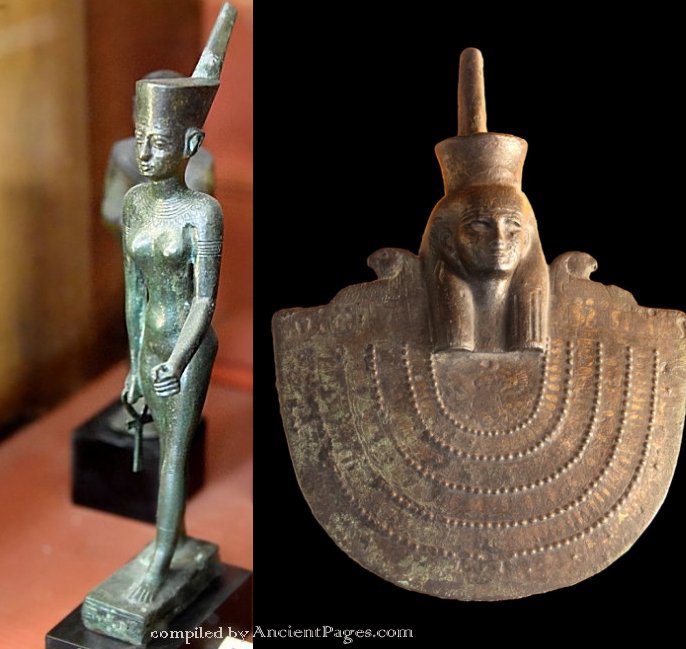Magnificent Pre-Dynastic City Of Sais And Its Lost Neglected Ruins
A. Sutherland - AncientPages.com - The history of Sais goes back to Egypt's pre-dynastic times (before 3100 BC). It was once a beautiful Egyptian city located in the western Egyptian delta along the right bank of the Rosetta Branch of the Nile River.
Left: Goddess Neith. Image credit: Osama Shukir Muhammed Amin FRCP(Glasg) - CC BY-SA 4.0; Right: Goddess Neith. Image credit: Right: Aegis of Neith, Twenty-sixth dynasty of Egypt - Museum of Fine Arts of Lyon. Rama - CC BY-SA 2.0 fr
Today, the only visible ruins of the city near the village of Sa al-Hadjar are dated to the Late New Kingdom (c.1100 BC).
There are no surviving traces of this town prior to this period of time, but it is scientifically attested that the history of Sais goes back to pre-dynastic times. From the 3rd millennium BC, Sais was a famous economic, political, and religious center of the goddess of war and hunting, Neith, whose temple was to be erected by the founder of the first Dynasty.
Known as a center for science and the arts, the city was first mentioned in inscriptions of the archaic period. However, it played an important role in all historical periods and was most important in the late ages. It was then the state capital during the reign of the XXIV and XXVI dynasties.
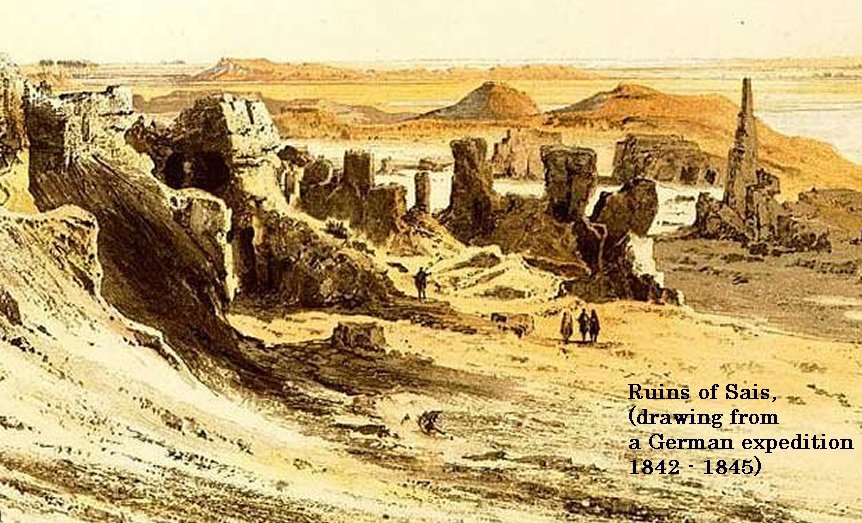
Herodotus and some other ancient sources confirm that Sais was a prestigious city of northern Egypt about 3100 BC, full of magnificent buildings and royal crypts, and the wives of the rulers of the first Dynasty (Merneit, Meritneit) had come from Sais.
Amasis, who ruled for 44 years and made many contributions to the country, was probably the 5th ruler of Egypt during the 26th Dynasty and has been called the last great Egyptian Pharaoh.
He established himself at Sais in Northern Egypt, and there – like in many other places in Egypt – he ordered the building of monumental buildings, including his tomb at Sais, which was unfortunately never discovered. Still, according to Herodotus' description, the tomb was beautiful:
'It is a great cloistered building of stone, decorated with pillars carved in the imitation of palm-trees, and other costly ornaments. Within the cloister is a chamber with double doors, and behind the doors stands the sepulchre…"
In the age of the Ptolemies (323 to 30 BC), Sais was an important center.
Ancient Sais was the center of the cult of the goddess of war and hunting, Neith, the patron goddess of Sais, a great protector of the people of the land, and the most accomplished mediator between humanity and the gods. From the Late Period (1000 BC onwards), the Neith temple was a center of pilgrimage.
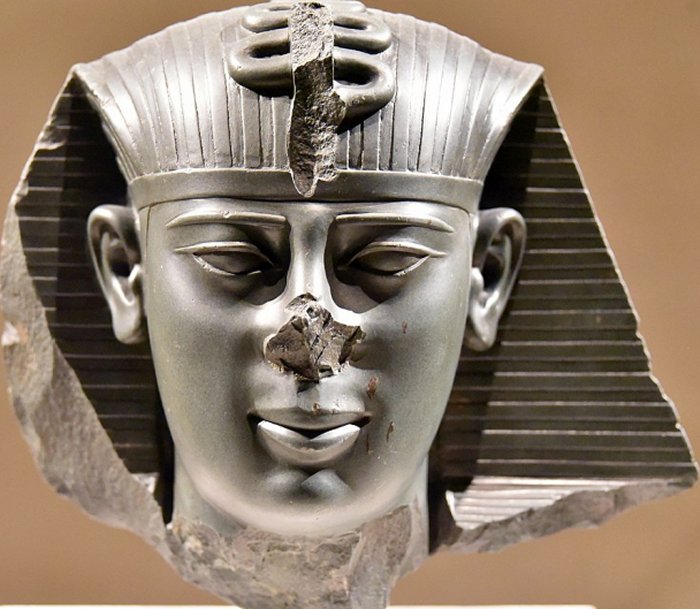 Head of Amasis II. Saite period, 26th Dynasty, c. 550 BCE. From Egypt. Neues Museum, Berlin, Germany. Greywacke, ÄM 11864. source
Head of Amasis II. Saite period, 26th Dynasty, c. 550 BCE. From Egypt. Neues Museum, Berlin, Germany. Greywacke, ÄM 11864. source
However, Sais had several other temples dedicated to the creator god Atum and one dedicated to the Egyptian Lord of the Underworld and Judge of the Dead, Osiris.
According to Herodotus, the grave of Osiris was located at Sais. The Temple of Sais had a medical school associated with it. The medical school at Sais had many female students and apparently women faculty, mainly in gynecology and obstetrics.
An inscription from the period survives at Sais and reads:
"I have come from the school of medicine at Heliopolis and have studied at the women's school at Sais, where the divine mothers have taught me how to cure diseases…".
Many kings of Sais were clever men; among them was King Nekau of the Twenty-sixth Dynasty, who ruled for 15 years and sent an expedition that circumnavigated Africa. King Nekau was the ruler who started the construction of a canal from the Nile to the Red Sea, later completed by the Achaemenid king Darius I.
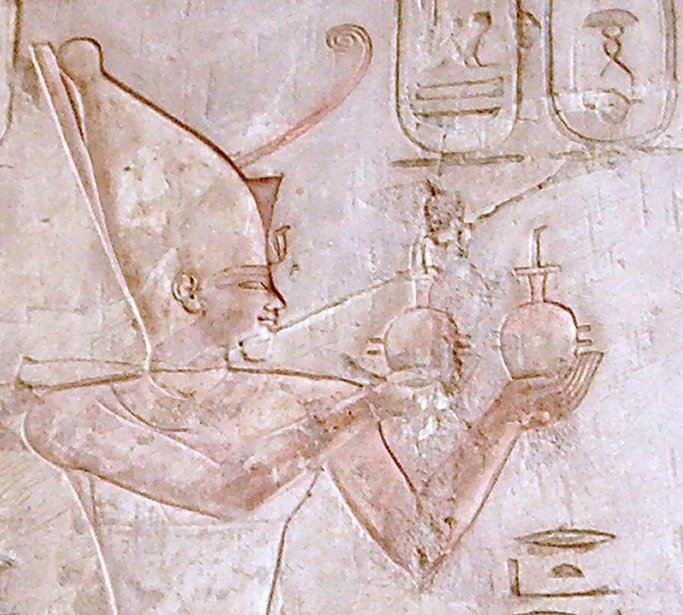 Relief of Psamtik I making an offering to Ra-Horakhty (Tomb of Pabasa). source
Relief of Psamtik I making an offering to Ra-Horakhty (Tomb of Pabasa). source
Necho I, appointed by the Assyrian king Esarhaddon, extended his jurisdiction over the Delta and Memphis after his conquest of Egypt in 671 BC. His son Psamtik I successfully reunited the whole of Egypt and founded the twenty-sixth Dynasty. Later, the successive kings of this Dynasty enlarged and embellished Sais.
The Persians invaded Egypt in 525 BC, just after Psamtek III became king. The fate of the city of Sais is not precisely known, but it is known that after ascending the throne, the Persian king Cambyses marched against Egypt, where he ruined the tomb of Amasis (also known as Ahmose II, which means "The Moon is Born, Son of Neith"). Moreover, he also thoroughly destroyed the city, including several temples.
The city was never subject to systematic archaeological research, and in ancient times, it was better known from historical sources of Herodotus and Strabo and descriptions of travelers.
Written by – A. Sutherland - AncientPages.com Senior Staff Writer
Updated on January 27, 2024
Copyright © AncientPages.com All rights reserved. This material may not be published, broadcast, rewritten or redistributed in whole or part without the express written permission of AncientPages.com
Expand for referencesMore From Ancient Pages
-
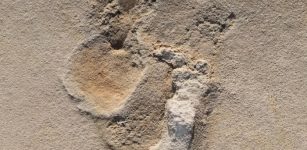 Oldest Footprints Of Pre-Humans Discovered In Crete – They Are 6 Million-Year-Old!
Archaeology | Oct 12, 2021
Oldest Footprints Of Pre-Humans Discovered In Crete – They Are 6 Million-Year-Old!
Archaeology | Oct 12, 2021 -
 Horus – One Of The Most Important Ancient Egyptian Gods And Symbol Of Rulership and Justice
Egyptian Mythology | Jun 26, 2018
Horus – One Of The Most Important Ancient Egyptian Gods And Symbol Of Rulership and Justice
Egyptian Mythology | Jun 26, 2018 -
 Beware Of The Night Marchers – Deadly Ghosts Of Warriors Who Kill With Just One Look
Featured Stories | Jul 23, 2019
Beware Of The Night Marchers – Deadly Ghosts Of Warriors Who Kill With Just One Look
Featured Stories | Jul 23, 2019 -
 Secret Tunnels Used By Knights Templar Leading To The Treasure Tower – Discovered
Archaeology | Oct 29, 2019
Secret Tunnels Used By Knights Templar Leading To The Treasure Tower – Discovered
Archaeology | Oct 29, 2019 -
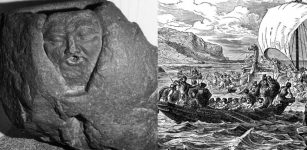 Ancient Mysteries Of Chicago: Is The Puzzling Waubansee Stone A Neglected Pre-Columbian Artifact?
Artifacts | Mar 4, 2017
Ancient Mysteries Of Chicago: Is The Puzzling Waubansee Stone A Neglected Pre-Columbian Artifact?
Artifacts | Mar 4, 2017 -
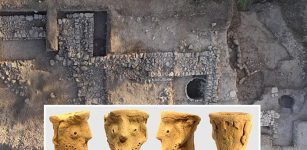 Mysterious Sanctioned Ancient Temple In Jerusalem Create Some Biblical ‘Problems’
Archaeology | Mar 5, 2020
Mysterious Sanctioned Ancient Temple In Jerusalem Create Some Biblical ‘Problems’
Archaeology | Mar 5, 2020 -
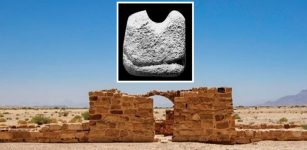 World’s Oldest Chess Piece Discovered At Humayma In Jordan?
Archaeology | Nov 26, 2019
World’s Oldest Chess Piece Discovered At Humayma In Jordan?
Archaeology | Nov 26, 2019 -
 Ancient Mystery Of America’s Missing Metal – Can The Answer Be Found In Ancient Europe?
Civilizations | May 18, 2018
Ancient Mystery Of America’s Missing Metal – Can The Answer Be Found In Ancient Europe?
Civilizations | May 18, 2018 -
 On This Day In History: Mathematician And Astronomer Simon Marius Independently Rediscovered Andromeda Galaxy – On Dec 15, 1612
News | Dec 15, 2016
On This Day In History: Mathematician And Astronomer Simon Marius Independently Rediscovered Andromeda Galaxy – On Dec 15, 1612
News | Dec 15, 2016 -
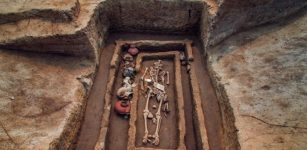 ‘Giants’ Discovered In Ancient Grave In China
Archaeology | Jul 6, 2017
‘Giants’ Discovered In Ancient Grave In China
Archaeology | Jul 6, 2017 -
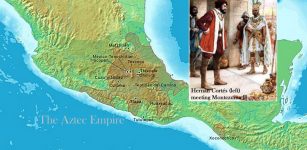 Aztec Empire: ‘Tlatoani’ – The Ruler With The Ultimate Power In The Land
Ancient History Facts | May 5, 2016
Aztec Empire: ‘Tlatoani’ – The Ruler With The Ultimate Power In The Land
Ancient History Facts | May 5, 2016 -
 Long-Lost Island Documented On Ancient Maps – Erased From History Or Misidentified?
Featured Stories | Dec 14, 2019
Long-Lost Island Documented On Ancient Maps – Erased From History Or Misidentified?
Featured Stories | Dec 14, 2019 -
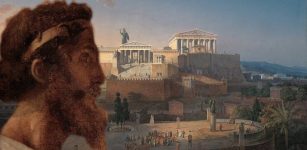 Popular Tyrant Peisistratos Tricked The Athenians To Seize Power And People Loved Him
Featured Stories | Jan 12, 2021
Popular Tyrant Peisistratos Tricked The Athenians To Seize Power And People Loved Him
Featured Stories | Jan 12, 2021 -
 Aqueducts Are Among Most Exceptional Achievements Of Ancient Roman Engineers
Ancient Technology | Apr 10, 2019
Aqueducts Are Among Most Exceptional Achievements Of Ancient Roman Engineers
Ancient Technology | Apr 10, 2019 -
 Matches Were Invented In Ancient China
Ancient History Facts | Mar 7, 2019
Matches Were Invented In Ancient China
Ancient History Facts | Mar 7, 2019 -
 World’s Oldest Tattoo Tools Discovered In Tennessee, North America
Archaeology | May 2, 2018
World’s Oldest Tattoo Tools Discovered In Tennessee, North America
Archaeology | May 2, 2018 -
 Dancing Around The Throne: Networking In TheTime Of King William I
Ancient Traditions And Customs | Jul 4, 2023
Dancing Around The Throne: Networking In TheTime Of King William I
Ancient Traditions And Customs | Jul 4, 2023 -
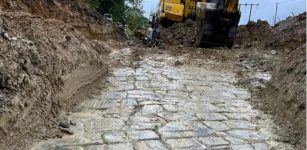 Hidden 2,000-Year-Old Roman Road Uncovered In Worcestershire Could Be Of ‘Global Importance’
Archaeology | Nov 12, 2022
Hidden 2,000-Year-Old Roman Road Uncovered In Worcestershire Could Be Of ‘Global Importance’
Archaeology | Nov 12, 2022 -
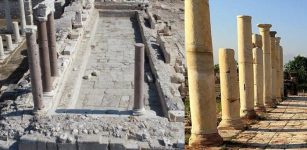 Massive 2nd-Century Fountain In Turkey’s Ancient City Of Tripolis Will Be Soon Restored
Archaeology | Aug 3, 2020
Massive 2nd-Century Fountain In Turkey’s Ancient City Of Tripolis Will Be Soon Restored
Archaeology | Aug 3, 2020 -
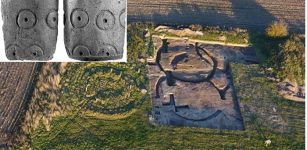 Dazzling Time Capsule Of Unique Iron Age Artifacts And Celtic Roundhouses Discovered In England
Archaeology | Mar 15, 2022
Dazzling Time Capsule Of Unique Iron Age Artifacts And Celtic Roundhouses Discovered In England
Archaeology | Mar 15, 2022

